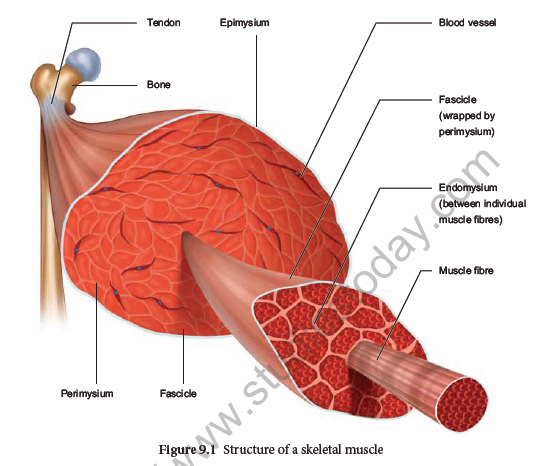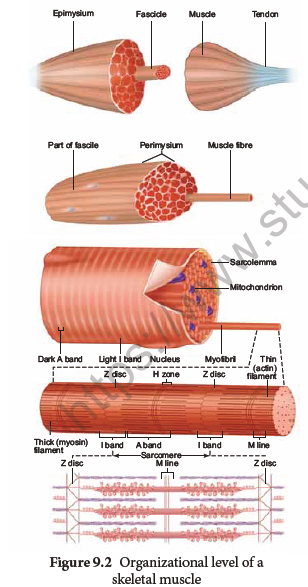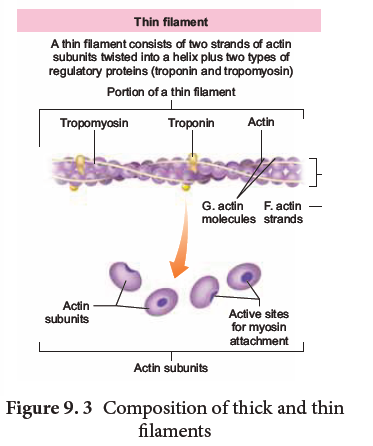Chapter Outline
9.1 Types of movement
9.2 Types of muscles
9.3 Skeletal muscle
9.4 Structure of contractile proteins
9.5 Mechanism of muscle contraction
9.6 Types of skeletal muscle contraction
9.7 Skeletal system and its functions
9.8 The Axial skeleton
9.9 The Appendicular skeleton
9.10 Types of joints
9.11 Disorders of muscular and skeletal system
9.12 Benefits of regular Exercise
Learning Objectives
• Relates the structure of skeletal muscle with its function.
• Learns to identify bones of the skeletal system.
• Gains knowledge about the disorders related to muscular and skeletal systems.
• Understands the benefi ts of regular exercise.
Have you ever wondered how a dancer performs intricate dance steps or how a swimmer skillfully does a butterfly stroke? The muscles of our body work simultaneously with one another and with the skeletal system to perform the various movements. Our muscles have two functions: to generate motion and force. All these activities are controlled and coordinated by the skeletal, muscular and nervous system. The human body is capable of a wide range of movements from the gentle blinking of eye to running a 20 km marathon. Movement of organism from one place to another in search of food, shelter, mate and to escape from predators is called locomotion. Locomotion has evolutionary significance.
9.1 Types of movement
The different types of movements that occur in the cells of our body are amoeboid, ciliary, flagellar and muscular movement. Amoeboid movement - Cells such as macrophages exhibit amoeboid movement for engulfing pathogens by pseudopodia formed by the streaming movement of the cytoplasm. Ciliary movement - This type of movement occurs in the respiratory passages and genital tracts which are lined by ciliated epithelial cells. Flagellar movement - This type of
movement occurs in the cells which are having flagella or whip-like motile organelle. The sperm cells show flagellar movement. Muscular movement -The movement of hands, legs, jaws, tongue are caused by the contraction and relaxation of the muscle which is termed as the muscular movement.
9.2. Types of muscles
Muscles are specialized tissues which are derived from the embryonic mesoderm.They are made of cells called myocytes and constitute 40 – 50 percent of body weight in an adult. These cells are bound together by a connective tissue to form a muscular tissue. The muscles are classified into three types, namely skeletal, visceral and cardiac muscles.
9.3 Skeletal muscle (Voluntary muscle)
Skeletal muscle is attached to the bone by a bundle of collagen fibres known as tendon (Figure 9.1). Each muscle is made up of bundles of muscle fibres called fascicle. Each muscle fibre contains hundreds to thousands of rodlike
structures called myofibrils that run parallel to its length. The connective tissue covering the whole muscle is the epimysium, the covering around each fascicle is the perimysium and the muscle fibre is surrounded by the endomysium.They control the voluntary actions such as walking, running, swimming, writing hence termed as voluntary muscles.
9.3.1. Structure of a skeletal muscle fibre
Each muscle fibre is thin and elongated.Most of them taper at one or both ends. Muscle fibre has multiple oval nuclei just beneath its plasma membrane or sarcolemma. The cytoplasm of the muscle fibre is called the sarcoplasm. It contains glycosomes, myoglobin and sarcoplasmic reticulum. Myoglobin is a red- coloured respiratory pigment of the muscle fibre.It is similar to haemoglobin and contains iron group that has affinity towards oxygen and serves as the reservoir of oxygen.Glycosomes are the granules of stored glycogen that provide glucose during the period of muscle fibre activity. Actin and myosin are muscle proteins present in the muscle fibre.
Along the length of each myofibril there are a repeated series of dark and light bands (Figure 9.2). The dark A-bands (Anisotropic bands) and the light I-bands (Isotropic bands) are perfectly aligned with one another.This type of arrangement gives the cell a striated appearance. Each dark band

has a lighter region in its middle called the H-Zone (H-helles, meaning clear).Each H-zone is bisected vertically by a dark line called the M-line (M-for middle). The light I-bands also have a darker mid line area called the
Z–disc (from the German "Zwischenscheibe" the disc inbetween the I-bands).
The myofibrils contain the contractile element, the sarcomere which is the functional unit of the skeletal muscle. A Sarcomere is the region of a myofibril between two successive Z-discs. It contains an A-band with a half I-band at each end. Inside the sarcomere two types of filaments are present namely the thick and thin filaments.
The thick filaments extend the entire length of the A-band, the thin filaments extend across the I-band and partly into the A-band. The invagination of the sarcolemma forms transverse tubules (T–tubules) and they penetrate into the junction between the A and I-bands.

9.4 Structure of contractile proteins
Contraction of the muscle depends on the presence of contractile proteins (Figure 9.3) such as actin and myosin in the myofilaments. The thick filaments are composed of the protein myosin which are bundled together whose heads produce at opposite ends of the filament. Each

myosin molecule is made up of a monomer called meromyosin. The meromyosin has two regions, a globular head with a short arm and a tail. The short arm constitutes the heavy meromyosin (HMM). The tail portion forms the light meromyosin (LMM). The head bears an actin-binding site and an ATP- binding site. It also contains ATPase enzyme that split ATP to generate energy for the contraction of muscle. The thin filaments are composed of two interwined actin molecules. Actin has polypeptide subunits called globular actin or G–actin and filamentous form or F-actin. Each thin filament is made of two F-actins helically wound to each other. Each F-actin is a polymer of monomeric G-actins. It also contains a binding site for myosin. The thin filaments also contain several regulatory proteins like tropomyosin and troponin which help in regulating the contraction of muscles along with actin and myosin.

